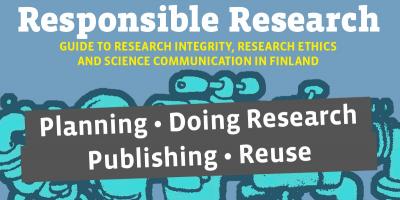The best way of identifying a research subject is by their name, but their identity can also be revealed by other information.
Protecting the privacy of research subjects is one of the most important principles of research integrity. Research publications place particular emphasis on this point. The main rule is to write up research findings so as to safeguard the anonymity of research subjects and any other people they mention. The identity of research subjects may be made public if research subjects are experts or public figures. The same applies if research subjects produce e.g. written works (poetry or similar) and including their name in research publications is expressly agreed with the research subjects concerned. However, revealing the identity of a research subject is the exception.
The main rule is to write up research findings so as to safeguard the anonymity of research subjects and any other people they mention.
It is relatively easy to design summaries, diagrams and tables used in statistical analysis so as to make it impossible to identify individual respondents from the results. In qualitative research reports, however, safeguarding the anonymity of research subjects demands careful consideration on a case by case basis, especially when using direct quotes from research data.
The best way of identifying a research subject is by their name, but their identity can also be revealed by other information. It is possible to combine several pieces of data to identify an individual rather than using one piece of information or hint. For example, the place of residence, age, occupation and sex of a research subject stated in extracts from the data will not in combination necessarily lead to identification if the research subject is a 35-year-old female nurse living in Helsinki and no other identifying factors are included in the publication. However, if the research subject is a 35-year-old female nurse living in Alavieska, which has a population of about 2,600 people, this background information alone could reveal who the research subject is to people living in that area.
The best way of identifying a research subject is by their name, but their identity can also be revealed by other information.
One way of safeguarding anonymity is to categorise the background information. For example, the place of residence of the research subject living in Alavieska could be given as the broader category of “a rural municipality in Northern Ostrobothnia”. This grouping includes 17 different municipalities, and identification solely based on age, occupation, sex and categorised place of residence is virtually impossible.
Because it is possible to combine several pieces of data to identify an individual, extracts from data cited in research publications should also be checked as a whole at individual level. If, for example, the research publication contains several direct extracts from the material from the nurse living in Northern Ostrobothnia, it must be checked that it is not possible to identify the person concerned by reading all the extracts about that person in isolation.
If the decision is made to make the identifying information less specific, all information should be removed from the extracts consistently. If the nurse talks about relaxing with her friends at the Hippu karaoke bar, a keen-eyed reader will spot that the person interviewed probably lives near the Hippu bar in Alavieska, although the background information provided about the location only mentions a rural municipality in Northern Ostrobothnia.
The necessity of background information about the research subjects is naturally determined by the needs of the research itself and it is essential to be consistent in selecting it. On the one hand, care should be taken that the necessary information for the analysis is conveyed to the reader, and on the other, it should be ensured that the anonymity of research subjects and any other people they mention is safeguarded. Guidelines for ensuring the anonymisation of research data also include solutions for anonymising extracts from data in research publications.
Arja Kuula-Luumi, Development Manager, Finnish Social Science Data Archive
Further information:
Data management handbook: Identifiability and anonymisation, http://www.fsd.uta.fi/aineistonhallinta/en/anonymisation-and-identifiers...
You might also be interested in
Tämä teos on lisensoitu Creative Commons Nimeä 4.0 Kansainvälinen -lisenssillä. Detta verk är licensierat under en Creative Commons Erkännande 4.0 Licens. This work is licensed under a Creative Commons Attribution 4.0 International license.
